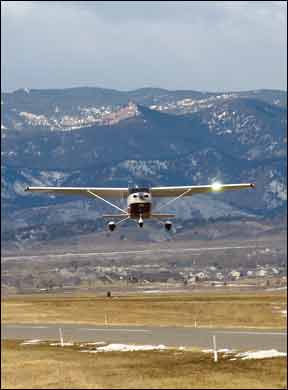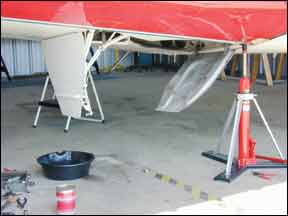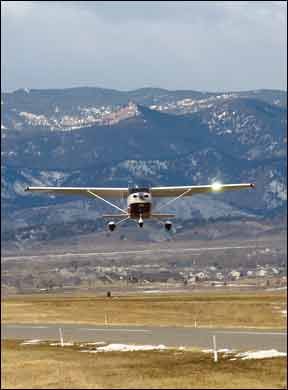Im always amused by pilots and non-pilots alike who express the view that landing is the most challenging portion of a flight. Yes, it can require all of our skills, but so can other segments, even straight-and-level cruising. The degree to which any flight segment poses a greater or lesser challenge depends on weather, terrain, aircraft loading-essentially all the variables were trained to consider and for which we compensate during our flight planning and execution. When merely considering the challenges posed, one of the oft-overlooked portions 288 of flight is what comes immediately after the airplane clears the runway on takeoff. Depending on things like density altitude, terrain, weather and aircraft loading, the initial climb to clear obstacles and reach a “safe” altitude easily can be the most challenging flight portion. The combination of variables can conspire to rob us of the relatively marginal performance we have right after liftoff, putting us in the weeds. Defining the problem First, lets clarify what we mean by “initial climb.” For this discussion, lets confine ourselves to the period between when the airplane lifts off from the takeoff surface-which could be pavement, turf or water-and when it reaches 1000 feet agl, the average airports pattern altitude. From that perch, we could be powering back to level off and stay in the pattern, pitching over to relatively low-level cruise flight or climbing to some higher altitude for our flights en route portion. We also need to stipulate our pre-flight planning has verified we have a long-enough takeoff area, that we can see and avoid any obstacles-and have adequate climb performance to clear them-and that we can deal with any mechanical problems encountered in that first 1000 feet. All of these variables can easily be in our favor right after liftoff, but we can still end up screwing the pooch. How? It depends on what we do, when we do it and how. For example, if our planning suggests we have performance adequate to clear the trees at the far end of the runway, but we do something stupid like failing to nail our best angle of climb speed (VX) or retract the flaps from their takeoff setting at the wrong time, the outcome will be in doubt. Likewise, we need to pay attention to any fine print in the POHs takeoff performance chart and ensure we do things in the proper order. Sometimes, and depending on the airplane, doing absolutely nothing on initial climb-except flying the airplane-until reaching our target 1000 feet agl is the best policy. Planning Any takeoff-even from our home drome-begins with some level of planning. If its our home runway on a standard day with a light load, that may be all we need to know and all the planning we need. We should be familiar with whats off the end of the departure runway, what speeds we need and under what conditions well abort the takeoff. For almost anything else, though, we may need to crack open the POH. If you havent looked at the takeoff performance charts in your POH lately, the sidebar at right might explain why. The POH is a great place to start, but thats all it is: a starting point. Once weve run through the books numbers on how much runway we should expect to consume, and how far well have traveled when crossing the mythical 50-foot obstacle, what else do we need to consider? How about engine failure? Where will you put the airplane if its sole power source takes a vacation? What about when flying a light twin that suddenly becomes a single? From time to time, these pages have discussed turning back to the departure runway after a singles engine failure. Generally, we strongly caution against it since the turn required and the available energy (read “altitude and airspeed”) necessary to pull it off are hard to estimate and even harder to obtain in the few seconds after liftoff. In some circumstances, it is possible, however to turn back toward the departure runway and eke out a successful landing, especially if your definition of “successful” includes airframe damage. Practice helps. Generally, however, circumstances under which a turnback is successful involve a very long runway, or an intersecting one. (For more on the dismal likelihood of a successful turnback after losing a singles engine, we refer you to Rich Stowells landmark research and discussion in our January 2006 issue.) Finally, our planning should include some idea of what well do and where well go on an instrument departure if things dont work out. Our normal answer to the takeoff-divert question is the nearest ILS, but that answer may not be appropriate in all circumstances. The point here is that even if the takeoff is successful, the initial climb may not be. You need a backup plan, which could be as simple as closing the throttle(s), landing straight ahead and calling the insurance company to tell them about the airplane they just bought from you. Got speed? As part of our pre-takeoff planning and making sure we know what well do if “something bad” happens, we also need to know what speed(s) to fly after liftoff, and when. The first speed we want is our initial liftoff speed. 288 All airplanes have a published liftoff speed; some of them vary with weight. Depending on the type of takeoff were performing-normal, short-field, soft-field-well either apply nose-up pitch to lift off when reaching that speed (normal and short-field takeoffs) or well have established the desired pitch early in the takeoff roll, allowing the airplane to do it all on its own during a soft-field takeoff. The real trick is knowing our initial climb target airspeed. Generally, this is not going to be the published VX or VY, best rate of climb. Why? Because most of the time were not going for maximum performance in our initial climb since there arent any obstacles to clear. Similarly, theres little reason to pitch for best rate since were not in a huge rush to get some altitude. Instead, were probably going to pitch for a speed higher than best rate, one which affords us good visibility over the nose, adequate engine cooling and more than an acceptable rate of climb. Using a speed higher than VY also gives us an extra safety margin in an engine-out situation. An engine failure when climbing out at a relatively high deck angle and low airspeed means we need to get the nose lowered, right now, whether were in a twin or a single. Ensuring the nose gets lowered immediately is one of the few things thatll prevent the classic stall/spin accident after an engine failure with the nose high, decaying airspeed and few options. What to Raise, and When Another matter of technique in the first 1000 feet after takeoff involves when to raise the gear and/or flaps, and in which order. Even if you fly a simple, fixed-gear, fixed-pitch airplane, there are occasions when a notch of flaps is called for, like on a soft-field takeoff. With other airplanes, raising the gear can greatly increase parasite drag as gear doors open and close, or the gear itself pivots and presents more surface area to the relative wind while its being stowed. Again, the airplanes POH guidance, if any, should be the determining factor. Pay particular attention to the sequence specified and be sure to avoid violating any speed-related limitations. For instance, some airplanes have a maximum landing-gear extended speed, VLE, which is higher than the published landing-gear-operating speed, VLO. For other airplanes, the two speeds are identical, or only VLE is published. The trick is to get the gear in the wells before exceeding the often-lower VLO speed, even if we can legally fly right up to VLE. Absent any guidance, or in circumstances not contemplated by the POH-a short- and soft-field takeoff, for instance-common sense and some knowledge of the airplane should suffice. On those occasions when flaps are used for takeoff, they generally should be retracted only when all obstacles, if any, are cleared and the resulting, temporary loss of lift wont result in the airplane settling back to the runway. This usually means waiting until theres some real air underneath the wings and the airplane has accelerated to near the top of the white arc. Youll minimize that sagging feeling by waiting until the airplane is fast before retracting the flaps. When to raise the landing gear is another age-old debate. Generally, we wait until we can no longer land on the departure runway. Its quite rare to be in a situation where getting the gear stowed immediately after breaking ground serves any purpose other than showing off. As mentioned above, raising the gear shortly after liftoff actually can reduce our initial climb rate, depending on the airplane. Bonanzas and Barons come to mind, since their gear-retraction cycle opens the inner gear doors, exposing the gear wells to the relative wind. Especially at high angles of attack-like when were maintaining VX to clear an obstacle-the additional drag can be a make-or-break problem. Other airplanes-retractable high-wing Cessnas, for example-present similar issues during their gear-retraction cycle. Your airplanes POH should include information on why or why not the gear should be raised, and when, along with whether to raise flaps first or gear. If it doesnt, try to get some input from others operating the same model, or from its type club. Putting it all Together The first 1000 feet after takeoff can be a time of uncertainty. The airplanes loading and performance might be suspect, for example. Were also a bit busier than at many other times during the flight, with flaps, gear and power to configure, along with navigating, communicating and aviating. A little planning goes a long way here, and if youve flown the airplane off that runway before, you already should know what to expect, when to expect it and what to do. Theres a first time for everything, of course, and the first time we really need to nail the correct airspeed, or get the retraction sequence right, shouldnt be the first-ever time weve done these things. A little practice makes perfect.





